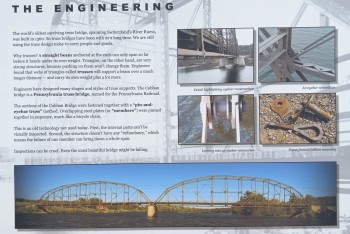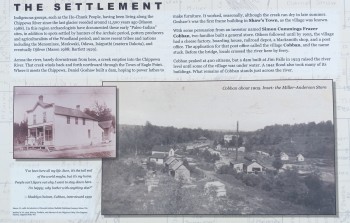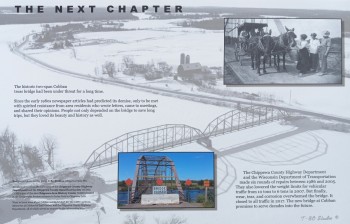|
The Cobban Bridge
 The original Cobban Bridge was brought up from
the Yellow River by Chippewa Falls in the winter
by the owner of the The original Cobban Bridge was brought up from
the Yellow River by Chippewa Falls in the winter
by the owner of the store to replace his ferry system with a more
efficient method of river crossing. This was accomplished before the
hydroelectric power dams
were built in Jim Falls and Chippewa Falls creating Lake Wissota in the early 1900's. The Bridge
was partially dismantled in Chippewa and was
pulled by teams of horses up the frozen river from Chippewa Falls on sleds (then called
Chippewa Junction) to Cobban. Amazing courage of the individuals that
make up this era. Imagine the mess if the bridge sections would have fallen through thin ice. The
positioning of the old Chippewa Bridge at Cobban over the Chippewa River allowed
customers to cross the river and shop at the store or drop milk off without making a thirty mile round trip in either
direction if store to replace his ferry system with a more
efficient method of river crossing. This was accomplished before the
hydroelectric power dams
were built in Jim Falls and Chippewa Falls creating Lake Wissota in the early 1900's. The Bridge
was partially dismantled in Chippewa and was
pulled by teams of horses up the frozen river from Chippewa Falls on sleds (then called
Chippewa Junction) to Cobban. Amazing courage of the individuals that
make up this era. Imagine the mess if the bridge sections would have fallen through thin ice. The
positioning of the old Chippewa Bridge at Cobban over the Chippewa River allowed
customers to cross the river and shop at the store or drop milk off without making a thirty mile round trip in either
direction if  they chose to not take the ferry. As they chose to not take the ferry. As the 70 ton capacity
bridge was in the final stages of set-up, Gottlieb Gerber and a few
others took a half barn door and painted on it "LOAD LIMIT FIVE
TONS" and hung it on the East end of the bridge. This was intended
as a joke and it stayed there until the some time in the 1940's. This
could be the beginning to the status of the bridge as a limit of
5 tons. This old girder bridge stood functionally until 2017 when an inspection deemed it to be unsafe. The bridge had one lane traffic, with hardwood cross-plank roadbed
with additional hardwood planks for the tire paths. As you walk or ride over on a bike, you can see
the water beneath through the gaps in the wooden planks. The replacement bridge was opened in 2023 with a ribbon cutting ceremony. The next bridge to the south was in Chippewa Falls or to the north was Cornell, depending on which direction
you wished to travel. the 70 ton capacity
bridge was in the final stages of set-up, Gottlieb Gerber and a few
others took a half barn door and painted on it "LOAD LIMIT FIVE
TONS" and hung it on the East end of the bridge. This was intended
as a joke and it stayed there until the some time in the 1940's. This
could be the beginning to the status of the bridge as a limit of
5 tons. This old girder bridge stood functionally until 2017 when an inspection deemed it to be unsafe. The bridge had one lane traffic, with hardwood cross-plank roadbed
with additional hardwood planks for the tire paths. As you walk or ride over on a bike, you can see
the water beneath through the gaps in the wooden planks. The replacement bridge was opened in 2023 with a ribbon cutting ceremony. The next bridge to the south was in Chippewa Falls or to the north was Cornell, depending on which direction
you wished to travel.
|
|
Cobban Floods
 A few floods over the last century
claimed much personal property, but the residents worked hard to keep
the community together. The picture at the left shows the Omaha
tracks under water during the flood of 1941. To the right side of the
tracks, the Cobban store can be seen. The depot is to the left almost directly
across the tracks from the white Cobban store. The lumber mill can be
seen as the larger building to the far right near the top. A few floods over the last century
claimed much personal property, but the residents worked hard to keep
the community together. The picture at the left shows the Omaha
tracks under water during the flood of 1941. To the right side of the
tracks, the Cobban store can be seen. The depot is to the left almost directly
across the tracks from the white Cobban store. The lumber mill can be
seen as the larger building to the far right near the top.
|
|
The Cheese Factory
 The
second Cheese Factory being built in Cobban in 1916 by the Shultz
Brothers. The building
stands today surviving many floods and time. Picture on left reflects 1916
while picture on right reflects nearly 90 years later. Milk was brought
in by the local farmers to be sold to the factory. Butter fat from
the milk was used to make cheese and other dairy products. The Factory
was a source of income for the dairy farmers as well as the employees of
the factory. The
second Cheese Factory being built in Cobban in 1916 by the Shultz
Brothers. The building
stands today surviving many floods and time. Picture on left reflects 1916
while picture on right reflects nearly 90 years later. Milk was brought
in by the local farmers to be sold to the factory. Butter fat from
the milk was used to make cheese and other dairy products. The Factory
was a source of income for the dairy farmers as well as the employees of
the factory.
|
|
Cobban Store
  The
second Cobban Store was rebuilt in 1923. It looked much like the first
one (shown on left) that was severely damaged in a flood in 1922. To the
right of the second store build was a weigh scale used for weighing
entire wagons of produce as they arrived for export. Sugar Beets and
potatoes were a common commodity for the Cobban area. The
second Cobban Store was rebuilt in 1923. It looked much like the first
one (shown on left) that was severely damaged in a flood in 1922. To the
right of the second store build was a weigh scale used for weighing
entire wagons of produce as they arrived for export. Sugar Beets and
potatoes were a common commodity for the Cobban area.
|
|
Cobban Depot
 Cobban
Depot was used for passenger service as well as processing the merchandise
that left and entered the Cobban Community. The Cobban
Depot was used for passenger service as well as processing the merchandise
that left and entered the Cobban Community. The siding near the
station was tended by Emmett Yeager. He used a small white horse to
position railroad cars so the could be loaded or unloaded. The cars
would
then be staged for pick-up by the Omaha as it came through on it's
scheduled stop. They would hitch the horse to the car and the horse
would lean into the traces (sometimes called tugs) and it would stay
leaning until the car began to move. Sometimes the
motion was started by a man with a tool called a "Johnson Bar"
by prying it under the wheel of the car. As it began to move the horse
would take bigger steps until the car was "spotted", then someone
would set the hand brake on the car. The horses job was then done until
siding near the
station was tended by Emmett Yeager. He used a small white horse to
position railroad cars so the could be loaded or unloaded. The cars
would
then be staged for pick-up by the Omaha as it came through on it's
scheduled stop. They would hitch the horse to the car and the horse
would lean into the traces (sometimes called tugs) and it would stay
leaning until the car began to move. Sometimes the
motion was started by a man with a tool called a "Johnson Bar"
by prying it under the wheel of the car. As it began to move the horse
would take bigger steps until the car was "spotted", then someone
would set the hand brake on the car. The horses job was then done until  the next car needed to be moved. The depot has been gone since shortly
after the flood of 1941.
the next car needed to be moved. The depot has been gone since shortly
after the flood of 1941.
|
|
Lumber and Shingle Mill
 Lumber
was an export from Cobban area. Many trees were transformed into
building material for area communities as well as residents of the
Cobban community. Shown at the left are stacks of lumber set to dry so
it can be used without warping after construction. Seasoned lumber was a
commodity that came from the "Big Mill" that kept Cobban
flourishing as long as it lasted. When the area became "logged
out" the lumber mill vanished as did much of the town. Lumber
was an export from Cobban area. Many trees were transformed into
building material for area communities as well as residents of the
Cobban community. Shown at the left are stacks of lumber set to dry so
it can be used without warping after construction. Seasoned lumber was a
commodity that came from the "Big Mill" that kept Cobban
flourishing as long as it lasted. When the area became "logged
out" the lumber mill vanished as did much of the town.
The Shingle Mill was originally owned by Stevens and
Jarvis Lumber Company of Eau Claire, Wisconsin and was later purchased
by Julius Miller who was part owner of the Cobban Store. The material
for manufacturing shingles came from around the Cobban area. There were
many logs lying in the woods that were either missed due to deep snow or
left to stay because of the red sawdust coming from the crosscut
saw. This would indicate that
the log might be getting soft inside. Only logs of solid stature
were accepted at saw mills years ago. Much of the lumber is made
today from what years ago was called
firewood. Also
material
for manufacturing shingles came from around the Cobban area. There were
many logs lying in the woods that were either missed due to deep snow or
left to stay because of the red sawdust coming from the crosscut
saw. This would indicate that
the log might be getting soft inside. Only logs of solid stature
were accepted at saw mills years ago. Much of the lumber is made
today from what years ago was called
firewood. Also  brought to the shingle mill was the tall stumps
that were still standing in the woods. Lumbermen would cut high to avoid
hollow bottoms in the trees. Another source of logs was called
"river pigs". These were logs that had been lodged in the
river bottom and long the sides of the river banks after log drives were
complete. The logs that were intended for shingles were cut into lengths
of 20 inches then fed through a horizontal saw, sorted, trimmed, and
bundled. brought to the shingle mill was the tall stumps
that were still standing in the woods. Lumbermen would cut high to avoid
hollow bottoms in the trees. Another source of logs was called
"river pigs". These were logs that had been lodged in the
river bottom and long the sides of the river banks after log drives were
complete. The logs that were intended for shingles were cut into lengths
of 20 inches then fed through a horizontal saw, sorted, trimmed, and
bundled.
|
|
Cobban Today

Cobban WI, viewed from across the
Chippewa river in the winter from the "River Road"
Highway 178 in 2017.
|
|
 |

|
|
Directly South of Cobban is a small outlet
from the river that required a small bridge to cross the entrance. This
particular bridge used log piles driven into the river bed for support. |
A 1920's style farm house in the background
between Cobban and the railroad bridge. The depot was located in this area would have
been the "Milk Pick-up" point for rail transportation from the
farm to the dairy just a few miles South |
|
Cobban in 2025 reflects a new bridge has replaced the old truss bridge.
Across the Chippewa River signs have been placed reflecting the history of the truss bridge as reflected below
|
|

|

|
|

|

|